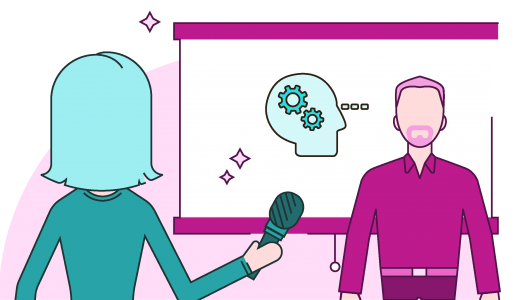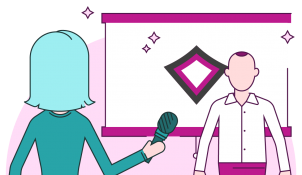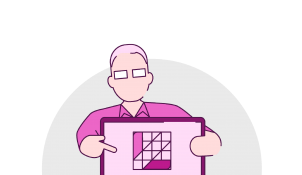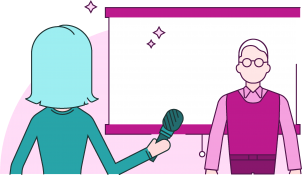Jamie Garroch puts the ‘power’ in PowerPoint add-ins. He’s written code for dozens of amazing functionality boosters, some for specific organizations and some available for all users, and he's joining the BrightCarbon team! Read on to learn about the experience that Jamie is bringing to BrightCarbon and how it will help clients and the presentation community use PowerPoint more effectively.
Insights from a graphics guru: Q&A with Mike Parkinson
- Written by: Kieran Chadha
- Categories: Industry insights

Mike Parkinson has become a leader in the graphics and presentation industry. He has made a name for himself in a number of different channels including a strong presence at graphics conferences and events, leadership in two major design companies, becoming a PowerPoint MVP, and writing a book—with another on the way! I’ve attended one of Mike’s events before, and he draws huge audiences in massive ballrooms. Needless to say, he’s got a lot going on and I was curious to see how he manages it all.
It must have been a huge honor be invited to join a company as part-owner. What was the state of the 24 Hour Company at the time they asked you to be a part of it?
24 Hour Company was a few talented people working out of someone’s basement. It was the result of the typical entrepreneurial spasm – someone was really good at something and they thought I should own a company doing it! Well, running a company and doing the work are very different skill sets so what the managing partner, Dennis Fitzgerald, figured out early on was that they were enjoying building and growing the business, but that means they can’t do the work. So, he looked for someone that was very good at the creative side, and willing to put in the time and the risk. I said yes! My focus was more about the visual communication, services side.
While there are many graphic designers out there, not many of them have a presence in the conference circuit, especially to the extent that you’ve achieved. How did you get involved in conferences?
There’s a gentleman by the name of Edward Tufte, he is a guru in the world of visual communication. I said [to my partners—Denis and Paul] ‘What would happen if Edward Tufte worked for our company?’ and they replied, ‘I would think that we could help more people and we would be more successful’. So, we set out to make me a variation of Edward Tufte, hoping people would look to me for thought leadership. I wrote a book about it, did a lot of public speaking and training for companies and government agencies. I also contributed hundreds of articles for websites like Washington Technology and to associations such as Association of Proposal Management Professionals (APMP) and the Association of Talent Development (ATD). It’s all about sharing the stuff that we’ve learned through trial and error so that others can get better at what they do. The benefit to us is that people can look to us for innovation, new ideas, best practices, and use our creative services.
How did it become such a big part of your life? How did it grow from I want to be this Edward Tufte kind of character to I am this Edward Tufte kind of character?
First, I figured out what would constitute an Edward Tufte kind of person? He speaks publicly, and he’s eloquent, so I needed to develop those skills. When I go to a conference and I walk away what are the things that make me say that person was the best I’ve ever seen, what is it about them? So, I tried to quantify that and see if I could ‘bottle it’ and recast for my personality, approach, and subject matter.
One day I threw my hat in the ring for a national conference, they said yes, and I was freaked out! Presenting there, I found out what worked and what failed. I learned lessons. After over 500 presentations, I’m still learning. There are so many amazing presenters out there, Richard is one of them. Richard is just spectacular. I worked on becoming a presenter who is (hopefully) kind, charming, knowledgeable, clever, generous,—all those things I admire and respect in great presenters and trainers. After I got pretty good at it, people said ‘Hey, we saw you at this conference, would you like to speak at ours?’.
The next phase was about 2 or 3 years ago. The next obvious step was keynotes, but who would want to see a keynote on graphics? Is that something that would get butts in seats and get people excited? For the right conference, yes. But I realized in growing a business I learned a lot, and that was something else I could speak to. I want to share experience not give advice. When people ask me a question about their career path or professional choices I’d say, ‘Well, I certainly can’t give you advice, but what I can say is this is what didn’t work for me and this is what did work’. People seem to like that because I’m not telling them what to do because I’m not them! They are good at things I am not and vice versa. So, I started crafting other seminars and speaking points that focused on experience-share and value-sharing; I do keynotes on professional development, infographics, creativity, solution architecture, marketing and sales, PowerPoint tips—it depends on the event. I only present on topics that I know intimately and I’m passionate about. Passion and enthusiasm is contagious. Its why my energy levels are so high.
One of the things you mentioned was to be a generous presenter, so what do you mean by that?
It’s putting participants before myself. I saw Simon Sinek present a keynote and I was blown away. He freely gave all the deepest wisdom and knowledge that he has learned to the audience and had no expectation of any compensation from the audience beyond the selfless act of sharing and helping. That resonated with me because I am not a fan of someone who shows up at a presentation and begins to sell their services or products. I will never forget one of the things he said, ‘the definition of a good leader is someone who puts others before themselves’ and that’s it, that’s my world. Another phrase I live by is, ‘if you help other people achieve their goals, you’ll achieve your goals’. Now ultimately, I have to pay my bills, however if I know something that will help you achieve your goals, I’m happy to share it. And that is a generous presenter.
You get huge audience in your speaking sessions. At this point does your reputation speak for yourself? What kinds of marketing do you do, if any, to draw these crowds?
Well, what I do isn’t necessarily the best practice. If I was doing it correctly I would seek out conferences where the focus and target audience dovetails with my expertise, because then I’m bringing the kind of value that audience is looking for. To date, what’s happened is organic growth—someone has read my book, an article I wrote or saw a clip of me and asked, ‘Are you interested in this conference?’, and I’m assuming that they’ve done their due diligence to see if I’m a good fit or not. To date, every conference and company that invited to speak has been a great fit. This is due to tailoring my presentations and training. However, when I’m on my game, I seek out opportunities that I know have the biggest impact and the best fit. I work with my awesome wife, Jennifer, and she helps me find a lot of opportunities. Sadly, I just don’t have the time to submit an abstract for all of the events I think are the best fit.
You’ve got two companies that you’re at least a part owner in, correct?
Yes, I am a partner at 24 Hour Company, which we’ve talked about, and then my other company is Billion Dollar Graphics. Billion Dollar Graphics focuses on products and training. 24 Hour Company is the services side and focuses on business development and proposals. At 24 Hour Co. we’re at 12 people right now. We grew up to 24 people and it was too big, so we pulled back.
How do you keep up with your design and graphics work on top of all your appearances?
We manage the workflow via what we call an air traffic controller. There are times where clients will say ‘okay we want someone on-site working with us’ and that person will be sitting there for 4 hours of the day, doing almost nothing. So, we manage expectations and recommend that our clients use us on-site when they need us, and off-site when they don’t. We’re at your beck-and-call just give us a holler and we’ll get our tuckuses out there, but don’t pay for us to be sitting there doing nothing. Due to that approach, our billable to overhead ratio is pretty high. The unfortunate side of things is that we’ve got to sometimes tell people that we’ll just cheer them on from the sideline because we are already booked.
Does Billion Dollar Graphics end up competing with the 24 Hour Company?
They don’t overlap, the only thing that’s a little bit of an overlap is they both do training, but 24 Hour Co. does training for proposals and solutioning and business development whereas Billion Dollar Graphics does training for presentations and PowerPoint. My books and things like that are through Billion Dollar Graphics. I’ve got a new tool coming out that I’m so stoked about.
Is that the PowerPoint add-on?
It is the PowerPoint add-on! Everyone I’ve showed it to in passing has just said ‘we want it’, which is a little scary because that means I probably won’t be able to make it available to everyone. At first the add-on will be invitation-only because I don’t want to grow too fast; I don’t want to sky rocket and then have the wheels come off. I want to make sure that whoever is using it loves it and we have the best possible solution.
This and steady growth seems to have been a theme in your career, is that something you attribute to your success?
In hindsight, yes. During the growth it was just the opposite—I was beating myself up for not having the explosive growth that I had seen in other agencies, like Duarte. So, in retrospect, yes, [slow and steady growth was a] wise decision. But at the time, I felt like we were failing because we weren’t growing the way we expected based on the effort we put in.
At what point did you start trying to become a PowerPoint MVP? Was is something you actively pursued or did it kind of fall into your lap?
I was unaware of what a PowerPoint MVP was until I attended Rick Altman’s presentation summit, which is an amazing conference. I met these people who were Microsoft MVPs and I quite frankly didn’t know enough to appreciate what that meant. The more I heard them talk the more, again, how generous I found them to be I thought, ‘wow these people are brilliant’. If you have a question they will pull themselves away from whatever they’re doing, sit down with you, and work it out. The more I worked with them, the more the MVPs thought, ‘Mike is working on some interesting stuff and shares what he learns, he might be a good candidate for MVP’. Around the same time, I felt that I would like to be considered for an MVP award, and I started asking what it would take. Long story short they nominated me. I don’t know if it was the first, second, or third year but Microsoft felt sorry for me and said yes. For years I was doing my best to align with, what I hoped was, what an MVP does. It essentially boiled down helping to evolve the industry and helping others.
In my interview with Sandra Johnson she mentioned that one of her goals for the Guild was to elevate the perception of the presentation industry so that one day when you go to select your job title from a drop-down menu, presentation designer will be an option. As a presentation professional what are your thoughts on this?
It is critical for the evolution of the industry. Asking a graphic designer to make a presentation – usually, not always – means that we’re going to have a professional-looking, aesthetically-appealing presentation. Asking a writer to create a presentation probably means you’ll have a well-articulated narrative that follows some structure. Asking a presentation designer to do it and you’re taking a piece of just about every industry, including design, writing, behavioral psychology, and more, so that you can get the best presentation. It looks at all of the variables holistically—the person speaking, the slides, content, messaging, videos, animation, interactivity, and whatever else you’re using so that people better understand, recall and adopt that which is being shared. That is a skillset that is not in any one of the standard labor categories that exists today. A presentation designer is kind of like a director; they need to understand cinematography, writing, pacing, story flows, how to get the actors to work well, etc. A director knows a little bit about every workflow in order to put it all together effectively. Without a new standard labor category that’s focused on synthesizing all these skillsets for this one purpose we’re not going to see the best stuff happen. We’re going to see slides with bullet points and clip art, because people that are making presentations aren’t looking at them the way a presentation designer would look at them.
Do you tend to do most of your work in PowerPoint, Illustrator, or another software? What do you like working with the best and why?
I mostly use the Adobe Suite because I have a background as a graphic designer. PowerPoint is not a graphics package – it is a presentation package. Now PowerPoint can do some graphics, if you know how. So while Adobe is where my heart is, PowerPoint is where the magic happens. Because of PowerPoint’s ubiquity it is, when done right, the most powerful tool in my arsenal because it allows the end user, my client, to massage it and have it continue to grow as their living document. As the presenter or facilitator is learning more, they can tailor the presentation. So yes, you can do it in Adobe and save it out as a PDF, however a lot of our end-users need to tailor and modify it for a specific need because the one thing that we’re learning throughout all business is we’ve got to do two things:
- Be agile because things are changing faster than ever before, and…
- We have to tailor our solutions, they cannot be one size fits all. There has to be tailoring to a particular audience’s needs. What are their goals? Hopes? Fears? Biases?
Building it in a tool like PowerPoint allows the end user to do just that—to be agile and tailor it.
Last question I have is about your book. At what point did that come into play? What motivated you to get it written?
Everything I read and learned from my mentors and people who have been successful in the industry said a few things about writing a book. One is you want to write a book because it lends credibility to who you are. Another, goes back to helping people be more successful. Many people don’t have time for a training course or can’t afford it, so you put everything in a book to try and help more people. Lastly, it is a business card on steroids. When someone comes to you and says, ‘why would I choose you over someone else?’, I can point them to my book and say ‘why don’t you take a look at it and see if I’m the right person for you’. It eliminates the risk of a poor choice by giving additional proof points. It’s the same thing with the Microsoft MVP, it’s like ‘hey Microsoft said I’m pretty good at this, I’ve also spoken at keynote conferences and I get great reviews!’. We need to help people to be successful and man does that make us happy.
I have another book coming out it’s called A Trainer’s Guide to PowerPoint: Best Practices for Master Presenters. After doing events with ATD for a number of years they asked me to write this book and I’m very proud of it. It’s about the best practices for coming up with and discovering what one needs to do for designing and delivering a presentation. That is going to come out in October of 2018.
So this is kind of an excellent example of helping other people reach their goals so that your goals get met too, huh?
Yes! And it goes back to that idea opportunity knocks, you answer. My schedule was so tight, but what a wonderful opportunity to share something I learned. It’s different than my last book because it’s not graphics, it’s presenting, and taking everything that I’ve learned and applying it to presentation development design—that’s awesome!
To learn more about Mike Parkinson’s work and services, please click here.
Leave a comment
Kieran Chadha
Principal consultant; Head of BrightCarbon Academy
View Kieran Chadha's profileRelated articles
- Presentation technology / Industry insights
- Comments: 2
think-cell is a PowerPoint add-on with chart and layout automation functions. Their latest update includes big data reporting capabilities and automatic layout generation. We got a special sneak preview of the latest version, and the inside scoop on the best features of the update from CEO and co-founder Markus Hannebauer.
Clark Quinn has made a career out of aligning corporate and organizational goals with learning science and computer science. He kindly agreed to let me pick his brain and find out what led him down the path to melding together technology and education disciplines.
Join the BrightCarbon mailing list for monthly invites and resources
Tell me more!BrightCarbon are a great partner in our growth. They are great to work with, very consultative, and professional. I could not recommend working with them more highly.
Neil Davidson Deltek



